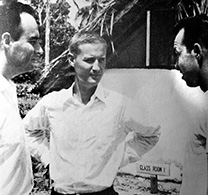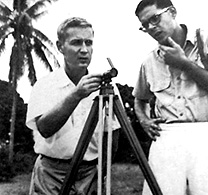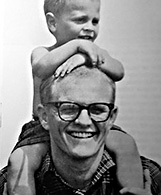Tanganyika’s First Peace Corps Staff
Lee St. Lawrence,* later to be Peace Corps Regional Director for the Far East, was the first person in the agency to conduct program negotiations overseas. This was in Tanganyika [renamed Tanzania in 1964] in March, 1961. The negotiations resulted in a program in which 30 Volunteer surveyors, geologists and engineers, went into training at Texas Western University in El Paso, inaugurated Peace Corps’ own Outward Bound site, Camp Crozier, in Puerto Rico, and climbed off a plane in Dar es Salaam on September 27, 1961.

Harris Wofford, Bob Hellawell & PCV Jim Belisle
Robert Hellawell
Several months before the Volunteers arrived in tanganyika, Sargent Shriver had a discussion with Associate General Counsel Robert Hellawell about the problems of getting first-rate people to run the programs overseas. Hellawell asked, “Would you consider me?”
Shriver later reported, “I was amazed. There was Bob, a competent, dedicated lawyer, and he wanted to go to Africa for the Peace Corps. This was the spirit that got the Peace Corps going.”
Hellawell had moved from the Cleveland law firm of Jones, Day, Cockley and Revis to come to the Peace Corps in April, 1961. As a partner in the firm he had been, at 32, one of the youngest partners of any major law firm in the United States. Some weeks were needed before he and his wife, Jane, were able to find an appropriate house in Washington and move in. “The very night Jane got the rugs on the floor,” Hellawell related, “I asked how she would like to go to Tanganyika. When she recovered from the shock, she said she thought it would be wonderful.”

Bob Hellawell and PCV Gene Schreiber
Although pleased to get Volunteers who would be living and working in the remote countryside, the government of Tanganyika requested that Peace Corps in-country staff be kept to a minimum. Consequently, Hellawell ran the program completely alone for almost his full two years.
“We were just plain lucky,” Shriver later commented, “that nothing went wrong.”
It was not until March 16, 1963, five months before Hellawell’s departure, that a second administrator arrived in Dar es Salaam. This was Field Officer John Hohl, who was familiar with East Africa through long experience as a professional hunter.
John Hohl
Born in Brooklyn, Hohl served as a Navy pilot in the last years of the Second World War He did three years of college work at the University of Toledo in Ohio, but left in 1949 to go to Switzerland, where he got a job as a salesman for a Berne drug firm. In February 1953, he became transportation manager for Paramount pictures, then went on location to Cairo for the shooting of “The Ten Commandments.” He reconnoitered six Egyptian locations and one in Sinai, set up all arrangements to move personnel and equipment to the right site at the right time. The next year he went to work as a professional hunter for Lawrence-Brown Safaris Ltd in Nairobi. In this capacity, taking safaris all through East Africa and the southern Sudan, Nyasaland, French Equatorial Africa and the Congo, he was in constant contact with local Africans for almost four years. Late in 1957 Hohl decided to go home , “because I felt it was time to settle down to a more normal life.” After a year as a manufacturing trainee with Ownes-Illinois Glass Company, he became a sales service coordinator for the firm’s operation in Glassboro, N.J.
But the opportunity to return to Africa with the Peace Corps was too much for him. Originally assigned to Nyasaland, he arrived in Blantyre on December 21, 1962 (the longest day of the southern year), and was transferred to Tanganyika less than four months later.
He served as Acting Representative in Dar es Salaam until the arrival of Deputy Representative Jim Blackwell on October 8, 1963.
Blackwell was from Anniston, Ala. He graduated from Western Reserve in Cleveland and earned an M.A. in sociology from Western, served the next two years as an instructor in biology at Benedict College in Columbus, S.C., then moved to Shorter College in Little Rock. He next taught at a series of colleges: Gambling, Washington State University, where he earned his Ph.D., and at San Jose State College. He also served there as the same time as the local coordinator for Operation Crossroads Africa.
The new Representative, Martin Chamberlain, was not scheduled to arrive until November, 1963, when he would accompany nearly eighty Volunteers who would be teaching English, math and science to grades seven and eight throughout Tanganyika.
 In late November, Don White moved into the office in Dar es Salaam as an Associate Director. White transferred over from the Peace Corps staff in Ghana, where he went to work in August, 1962, as a Field Officer.
In late November, Don White moved into the office in Dar es Salaam as an Associate Director. White transferred over from the Peace Corps staff in Ghana, where he went to work in August, 1962, as a Field Officer.
•
Research Document: Who’s Who in the Peace Corps Overseas Administration (1963)
The photographs are by Rowland Scherman, Paul Conklin and Jim Walls, first photographers for the agency.
*(There is a book entitled Lee St. Lawrence: The Man Behind the Peace Corps written by Pierre and Joan Delva . . .
but Lee wasn’t “behind the Peace Corps.” The book gives him credit that wasn’t his. Lee, however, did contribute greatly to the early Peace Corps development.)
Thanks John
I love the history you keep alive
I remember hitch hiking through Tanzania in 1966. Lots of stories
Paul and Printice Sack were country directors. Great leaders in SF but loved this job the most🌍of course
Patti and John